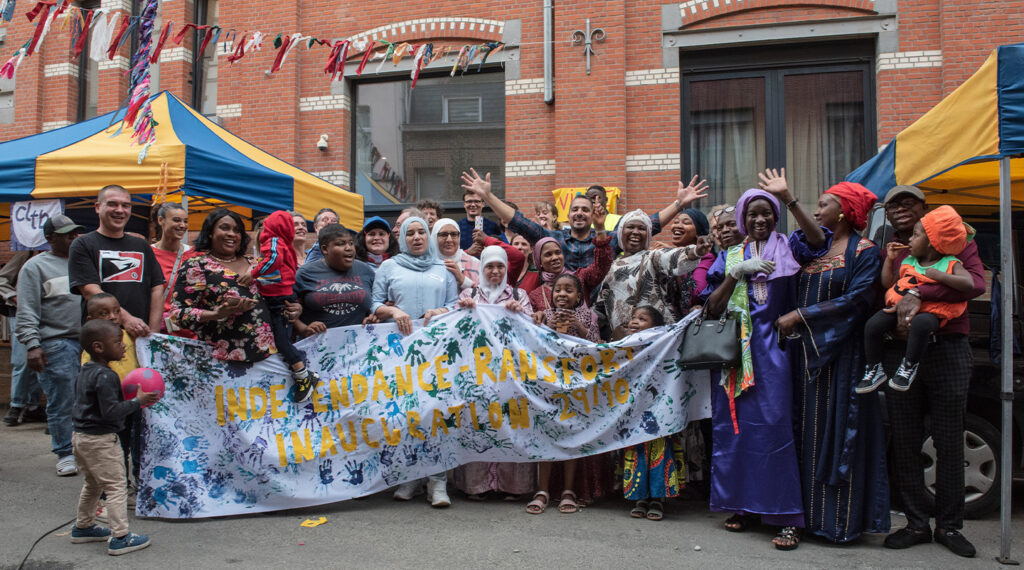How affordable housing helps tackle social inequality: The Community Land Trust Model

Tell us a few things about you and how you’ve come to do the work you do?
I am trained as a social worker and community builder, and working in Brussels with underprivileged communities I very soon understood the importance of good and affordable housing to tackle social inequality. In 2008, following a study visit to the Champlain Housing Trust in the USA, and together with a small group of other enthusiasts, we started to study the Community Land Trust (CLT) model, and to advocate and campaign for the creation of a CLT in Brussels. In 2013, we founded one.
What makes a CLT innovative and how does it work?
In Brussels, our CLT mainly focuses on providing affordable housing for low-income people in a city with very little social housing and without any restrictions on rents, where rising housing prices have a direct effect on the poorest. When we realised that it would take a very long time before the traditional operators would produce enough affordable, public housing, we decided to look for a community-led model that could guarantee lasting affordability, and that could give people in housing need an active role. A model that could adjust the root cause of the problem, a model that could contribute to changing the housing system itself. Community Land Trusts provided an answer.
CLTs view land as a common good, to be used in the interest of the community, and not as an asset to accumulate wealth. They divide ownership of the land from the ownership of the building, through long-term lease contracts. The CLT becomes the owner of the land, and commits to never sell it. Homes on CLT-land are owned by the homeowners, and as they don’t have to buy the land, the homes become affordable. When they later want to resell their home, it will be at a limited price. In that way, the home stays affordable for low-income families forever. In the same way, CLTs can develop rental or cooperative housing and other community assets.
CTLs are governed in a democratic way, involving residents, neighbours and public authorities. There is a wide variation among CLTs, but most of them combine these elements in one or another way.
Where did the model originate from?
CLTs are rooted in a long history of social movements around common land ownership. The first actual has its origin in the Civil Rights Movement in the United States. New Communities Inc was set up by civil right activists in the South as a way of securing land and housing for black sharecroppers. From there on, the model slowly spread in the US, and became more and more applied in urban contexts. The Champlain Housing Trust in Burlington was the first CLT to be developed with the support of the city government. In 2008, they won the World Habitat Award, delivered by World Habitat and the United Nations to the world’s best housing project. This was instrumental for the growth of the CLT movement worldwide. It is through this prize that we learned about the CLT-model.
In mainland Europe, we were the first to set up a CLT. Since our creation, many other CLTs were founded in Belgium, France, Holland and Germany.
Which are the drivers that create the current housing crisis (in Belgium /Europe)?
There are many reasons. For Brussels specifically, one of the important drivers is the presence of many international institutions, which attract wealthier inhabitants who are able to pay higher rents. Another important reason is the lack of social housing. For many years, the government didn’t invest in building new public and affordable housing. Only over the last ten years have things slowly started to change, but nowhere near fast enough. Furthermore, the current crisis is intensified by the global issue of financialising housing. Global investors consider housing as a valuable asset, thus increasing the pressure on housing markets.
Beyond access to affordable housing, you’re also creating a community that has a positive impact on residents – could you talk briefly about this work and the change you’ve been making?
One of the main premises of our work is that the poor communities we want to serve are part of the solution. Our target audience are people on low incomes with very diverse backgrounds. The vast majority is born outside Belgium.
Residents live together in our housing projects and become responsible for the management of their homes and housing projects. In order to facilitate this, we invest a lot of time in training and coaching the future homeowners, starting two years before they move into their new homes. Our future residents are also involved in their design, and we also help them set up initiatives that stimulate community life. In our housing projects, residents and volunteers have set up community kitchens, after-school tutoring, bicycle lessons, shared gardens, neighbourhood parties and so on. This improves social cohesion within the neighbourhoods, and as we build most of our homes in underprivileged neighbourhoods such as Molenbeek, this is important.
The residents not only play a central role within our housing projects, they are also represented in our board and thus have an important say in the strategy of our organisation. The combination of private ownership, providing security to low-income families, the possibility to build some equity, and the strong community dimension, is a good breeding ground for better neighbourhoods.
Does your approach aim to demonstrate alternatives or change at scale?
We try to develop the best possible projects in order to demonstrate how this new community-led, non-speculative approach can contribute to more just and resilient cities. After more than 10 years of activities, we delivered proof of concept, and we hope this will help us to bring it to a higher scale now. We try to convince the regional government to give our organisation a higher budget to increase the number of homes we can develop (although the current economic situation, with rising building costs and interests, makes this very difficult).
We are now studying the role we can play in the energy-renovation strategy in our city, how we can contribute to providing more homes for the homeless, how our approach can be used to develop other community assets such as space for the social economy, and so on. Finally, we want to question the existing housing and ownership model. Although housing is a human right, in reality houses are often used as an asset to create more wealth for the few. Community Land Trusts show the way to a new, more just, approach.
What is the aim of the European network of CLTs?
The main goal is for CLTs to be recognised as a mainstream option for affordable, inclusive and sustainable land use and housing across Europe. We want to demonstrate how this innovative approach delivers both social and environmental impact.
How could foundations support and engage with this work?
First of all, we believe it is essential that the government supports the development of affordable housing in order to guaranty the right to housing. However, the support that we received from many foundations was essential for our survival and our growth. Grants enabled us to cover the costs that come with social innovation – we cannot maintain our community building activities, so crucial to our work, without grants from foundations. Unfortunately we often have to choose between sustainability and affordability, and we don’t have the capacity to finance the extra costs upfront, so grants could help us to make more advanced and progressive choices. But they are not the only tool. Building homes is very capital intensive, so we need loans, bonds, equity… very often the return on investment we can offer is too low, even for impact investors. Finally, the support of foundations is essential to guarantee our autonomy, which is one of our main strengths. If we only depended on public money, there would be a risk that we’d be fully incorporated by the government, which would strongly limit our capacity for innovation.
A second impact report for Community Land Trust Brussels is available to download now.
Authors

